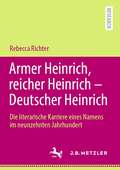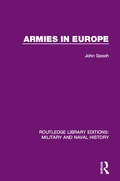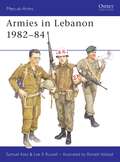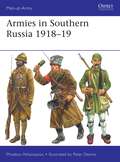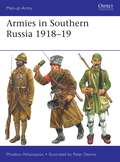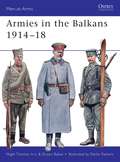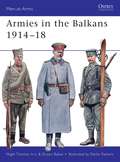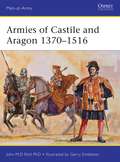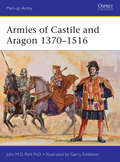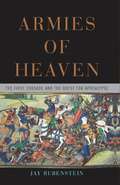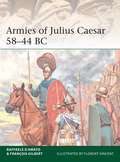- Table View
- List View
The Armenians in the Medieval Islamic World: Armenian Realpolitik in the Islamic World and Diverging Paradigmscase of Cilicia Eleventh to Fourteenth Centuries
by Seta B. DadoyanIn the second of a three-volume work, Seta B. Dadoyan explores the Armenian condition from the 970s to the end of the fourteenth century. This period marked the gradual loss of semi-autonomy on the traditional mainland and the rise of Armenian power of diverging patterns in southeastern Asia Minor, north Syria, Cilicia, and Egypt. Dadoyan's premise is that if Armenians and Armenia have always been located in the Middle East and the Islamic world, then their history is also a natural part of that region and its peoples. She observes that the Armenian experience has been too complicated to be defined by simplistic constructs centered on the idea of a heroic, yet victimized nation. She notes that a certain politics of historical writing, supported by a culture of authority, has focused sharply on episodes and, in particular, on the genocide. For her sources, Dadoyan has used all available and relevant (primary and secondary) Armenian sources, as well as primary Arab texts and sources. This book will stimulate re-evaluation of the period, and re-conceptualizing Armenian and Middle Eastern histories.
The Armenians in the Medieval Islamic World: The Arab Period in Armnyahseventh to Eleventh Centuries (Armenian Studies)
by Seta B. DadoyanIn this first of a massive three-volume work, Seta B. Dadoyan studies the Armenian experience in the medieval Islamic world and takes the reader through hitherto undiscovered paradigmatic cases of interaction with other populations in the region. Being an Armenian, Dadoyan argues, means having an ethnic ancestry laden with narratives drawn from the vast historic Armenian habitat. Contradictory trends went into the making of Armenian history, yet most narratives fail to reflect this rich texture. Linking Armenian-Islamic history is one way of dealing with the problem. Dadoyan's concern is also to outline revolutionary elements in the making of Armenian ideologies and politics. This extensive work captures the multidimensional nature of the Armenian experience in the medieval Islamic world. The author holds that every piece of literature, including historical writing, is an artifact. It is a composition of many elements arranged in certain forms: order, sequence, proportion, detail, intensity, etc. The author has composed and arranged the larger subjects and their sub-themes in such a way as to create an open, dynamic continuity to Armenian history that is intellectually intriguing, aesthetically appealing, and close to lived experiences.
The Armenians of Aintab: The Economics of Genocide in an Ottoman Province
by Ümit KurtA Turk’s discovery that Armenians once thrived in his hometown leads to a groundbreaking investigation into the local dynamics of genocide. Ümit Kurt, born and raised in Gaziantep, Turkey, was astonished to learn that his hometown once had a large and active Armenian community. The Armenian presence in Aintab, the city’s name during the Ottoman period, had not only been destroyed—it had been replaced. To every appearance, Gaziantep was a typical Turkish city. Kurt digs into the details of the Armenian dispossession that produced the homogeneously Turkish city in which he grew up. In particular, he examines the population that gained from ethnic cleansing. Records of land confiscation and population transfer demonstrate just how much new wealth became available when the prosperous Armenians—who were active in manufacturing, agricultural production, and trade—were ejected. Although the official rationale for the removal of the Armenians was that the group posed a threat of rebellion, Kurt shows that the prospect of material gain was a key motivator of support for the Armenian genocide among the local Muslim gentry and the Turkish public. Those who benefited most—provincial elites, wealthy landowners, state officials, and merchants who accumulated Armenian capital—in turn financed the nationalist movement that brought the modern Turkish republic into being. The economic elite of Aintab was thus reconstituted along both ethnic and political lines. The Armenians of Aintab draws on primary sources from Armenian, Ottoman, Turkish, British, and French archives, as well as memoirs, personal papers, oral accounts, and newly discovered property-liquidation records. Together they provide an invaluable account of genocide at ground level.
Armenia's Future, Relations with Turkey, and the Karabagh Conflict
by Levon Ter-PetrossianThis project addresses recurring questions about Armenian-Turkish relations, the legacy of the Armenian genocide of 1915, and relations between the Armenian diaspora and the Republic of Armenia. Additionally, it discusses the ongoing conflict with Azerbaijan, and the Armenian government’s handling of the commemoration of the one-hundredth anniversary of the Armenian genocide.
Armer Heinrich, reicher Heinrich - Deutscher Heinrich: Die literarische Karriere eines Namens im neunzehnten Jahrhundert
by Rebecca RichterDer Eigenname ist als sprachliches Phänomen Gegenstand vielfältiger wissenschaftlicher Betrachtung. In der Literatur erfüllt er seine Funktion unter anderem durch sein assoziatives Potenzial, das im Einzelwerk herauszuarbeiten eine literaturwissenschaftliche Grunddisziplin darstellt. Nun wird die deutsche Literatur des neunzehnten Jahrhunderts von einem einzelnen Namen in auffälliger Weise dominiert, nicht nur ob seiner Häufigkeit, sondern vor allem durch die prominente Platzierung in den großen und größten Werken dieser Zeit. Heinrich von Ofterdingen steht neben Heinrich Faust, der grüne Heinrich neben der Königlichen Hoheit Klaus Heinrich. Dabei ist der Eigenname per definitionem zu keiner Zeit ein unbeschriebenes Blatt. Rebecca Richter zeigt, dass der deutsche Herrschername schlechthin durch das neunzehnte Jahrhundert zum deutschen Dichtermythos erweitert wird, dem Künstler-Ich, das in einer sich modernisierenden und ökonomisierenden Welt entweder flüssig wird, oder sich verflüchtigt: Die Anlage zu beidem bringt Heinrich bereits im Namen mit.
Armies and Political Change in Britain, 1660-1750
by Hannah SmithArmies and Political Change in Britain, 1660 -1750 argues that armies had a profound impact on the major political events of late seventeenth- and early eighteenth-century Britain. Beginning with the controversial creation of a permanent army to protect the restored Stuart monarchy, this original and important study examines how armies defended or destroyed regimes during the Exclusion Crisis, Monmouth's Rebellion, the Revolution of 1688-1689, and the Jacobite rebellions and plots of the post-1714 period, including the '15 and '45. Hannah Smith explores the political ideas of 'common soldiers' and army officers and analyses their political engagements in a divisive, partisan world. The threat or hope of military intervention into politics preoccupied the era. Would a monarch employ the army to circumvent parliament and annihilate Protestantism? Might the army determine the succession to the throne? Could an ambitious general use armed force to achieve supreme political power? These questions troubled successive generations of men and women as the British army developed into a lasting and costly component of the state, and emerged as a highly successful fighting force during the War of the Spanish Succession. Armies and Political Change in Britain, 1660 - 1750 deploys an innovative periodization to explore significant continuities and developments across the reigns of seven monarchs spanning almost a century. Using a vivid and extensive array of archival, literary, and artistic material, the volume presents a striking new perspective on the political and military history of Britain.
Armies and Political Change in Britain, 1660-1750
by Hannah SmithArmies and Political Change in Britain, 1660 -1750 argues that armies had a profound impact on the major political events of late seventeenth- and early eighteenth-century Britain. Beginning with the controversial creation of a permanent army to protect the restored Stuart monarchy, this original and important study examines how armies defended or destroyed regimes during the Exclusion Crisis, Monmouth's Rebellion, the Revolution of 1688-1689, and the Jacobite rebellions and plots of the post-1714 period, including the '15 and '45. Hannah Smith explores the political ideas of 'common soldiers' and army officers and analyses their political engagements in a divisive, partisan world. The threat or hope of military intervention into politics preoccupied the era. Would a monarch employ the army to circumvent parliament and annihilate Protestantism? Might the army determine the succession to the throne? Could an ambitious general use armed force to achieve supreme political power? These questions troubled successive generations of men and women as the British army developed into a lasting and costly component of the state, and emerged as a highly successful fighting force during the War of the Spanish Succession. Armies and Political Change in Britain, 1660 - 1750 deploys an innovative periodization to explore significant continuities and developments across the reigns of seven monarchs spanning almost a century. Using a vivid and extensive array of archival, literary, and artistic material, the volume presents a striking new perspective on the political and military history of Britain.
Armies and State-building in the Modern Middle East: Politics, Nationalism and Military Reform (Library of Modern Middle East Studies)
by Stephanie CroninThe uprisings of 2011, which erupted so unexpectedly and spread across the Middle East, once again propelled the armies of the region to the centre of the political stage. Throughout the region, the experience of the first decade of the twenty-first century provides ample reason to re-examine Middle Eastern armies and the historical context which produced them. By adding an historical understanding to a contemporary political analysis, Stephanie Cronin examines the structures and activities of Middle Eastern armies and their role in state- and empire-building. Focusing on Iran, Afghanistan and Saudi Arabia, Armies, Tribes and States in the Middle East presents a clear and concise analysis of the nature of armies and the differing guises military reform has taken throughout the region. Covering the region from the birth of modern armies there in the late-nineteenth and early-twentieth centuries, to the military revolutions of the 1950s and 60s and on to the twenty-first century army-building exercises seen in Iraq and Afghanistan, Cronin provides a unique and vital presentation of the role of the military in the modern Middle East.
Armies in Europe (Routledge Library Editions: Military and Naval History)
by John GoochThis book, originally published in 1980, is a study of the nature and purposes of peace-time military organization in Europe, and of the characteristics and outcome of the major wars fought during these years. It charts the rise of mass armies and the role of conscription as a socializing agent and a military instrument, as well as discussing the growing involvement of society in war both as agent and target of military activity, the mounting effort required of a society in order to ahcieve victory, culminating in the ‘Total War’ of 1939-45. Among other subjects explored are the development of war economies, the genesis and significance of war aims, the importance of social cohesion in modern war and the impact of technology.
Armies in Europe (Routledge Library Editions: Military and Naval History)
by John GoochThis book, originally published in 1980, is a study of the nature and purposes of peace-time military organization in Europe, and of the characteristics and outcome of the major wars fought during these years. It charts the rise of mass armies and the role of conscription as a socializing agent and a military instrument, as well as discussing the growing involvement of society in war both as agent and target of military activity, the mounting effort required of a society in order to ahcieve victory, culminating in the ‘Total War’ of 1939-45. Among other subjects explored are the development of war economies, the genesis and significance of war aims, the importance of social cohesion in modern war and the impact of technology.
Armies in Lebanon 1982–84 (Men-at-Arms)
by Ronald Volstad Sam Katz Lee E RussellThe Lebanese Civil War of 1975-76 caused 80,000 dead and totally split the country along factional lines. An estimated 50 different militias came into existence, and acts of violence were both individual and collective. In the midst of this explosive atmosphere, cross-border conflict between Israel and Lebanon intensified, culminating in Operation Peace for Galilee the invasion of Lebanon. This book offers a day-by-day account of the invasion and the subsequent siege of Beirut, an operation that resulted in both the PLO and Israel claiming victory. Numerous photographs and colour plates portray the uniforms and equipment of the Israeli, Palestinian and Multi-National forces.
Armies in Lebanon 1982–84 (Men-at-Arms)
by Ronald Volstad Sam Katz Lee E RussellThe Lebanese Civil War of 1975-76 caused 80,000 dead and totally split the country along factional lines. An estimated 50 different militias came into existence, and acts of violence were both individual and collective. In the midst of this explosive atmosphere, cross-border conflict between Israel and Lebanon intensified, culminating in Operation Peace for Galilee the invasion of Lebanon. This book offers a day-by-day account of the invasion and the subsequent siege of Beirut, an operation that resulted in both the PLO and Israel claiming victory. Numerous photographs and colour plates portray the uniforms and equipment of the Israeli, Palestinian and Multi-National forces.
Armies in Southern Russia 1918–19 (Men-at-Arms)
by Phoebus AthanassiouAn important aspect of the Russian Civil War were the several Allied expeditions immediately following World War I in support of the disunited Russian 'White' armies resisting the Bolshevik Revolution. Although they ended in failure, these ventures were long resented, and were the origin of the 70-year-long Soviet suspicion of the Western Allies. British and US expeditionary forces operated in North Russia and Siberia in support of General Yudenich and Admiral Kolchak respectively, and a French and Greek expeditionary force (plus Romanian and Polish elements) operated in Crimea and south-western Ukraine, in support of General Denikin. The situation was further complicated by the presence of strong Imperial German elements still under arms, and by war between various factions in the Ukraine. This Southern theatre of the Allied interventions is far less well known than that of the British and Americans in the North and East.Featuring rare photos and new colour plates, this fascinating new book describes this major Allied intervention in the Russian Civil War. Dr Phoebus Athanassiou writes a compelling account of how the French and Greeks alongside White Russians were greatly outnumbered by pro-Bolshevik forces and were relentlessly pushed back by the Ukrainian forces. In just over 4 months, on 28 April 1919, the last of their forces were evacuated by Allied navies from Sevastopol in Crimea.
Armies in Southern Russia 1918–19 (Men-at-Arms #540)
by Phoebus AthanassiouAn important aspect of the Russian Civil War were the several Allied expeditions immediately following World War I in support of the disunited Russian 'White' armies resisting the Bolshevik Revolution. Although they ended in failure, these ventures were long resented, and were the origin of the 70-year-long Soviet suspicion of the Western Allies. British and US expeditionary forces operated in North Russia and Siberia in support of General Yudenich and Admiral Kolchak respectively, and a French and Greek expeditionary force (plus Romanian and Polish elements) operated in Crimea and south-western Ukraine, in support of General Denikin. The situation was further complicated by the presence of strong Imperial German elements still under arms, and by war between various factions in the Ukraine. This Southern theatre of the Allied interventions is far less well known than that of the British and Americans in the North and East.Featuring rare photos and new colour plates, this fascinating new book describes this major Allied intervention in the Russian Civil War. Dr Phoebus Athanassiou writes a compelling account of how the French and Greeks alongside White Russians were greatly outnumbered by pro-Bolshevik forces and were relentlessly pushed back by the Ukrainian forces. In just over 4 months, on 28 April 1919, the last of their forces were evacuated by Allied navies from Sevastopol in Crimea.
Armies in the Balkans 1914–18 (Men-at-Arms)
by Nigel Thomas Darko Pavlovic Dusan BabacRecent history should remind us that it was events in the Balkans which sparked off the Great War, with the assassination of the Austrian heir Prince Franz Ferdinand in Sarajevo, and the consequent invasion of Serbia by Austro-Hungarian armies on 2 August 1914. Nevertheless, the subsequent four-year war in that theatre is always overshadowed by the simultaneous campaigns on the Western Front. For the first time this book offers a concise account of these complex campaigns, the organisation, orders of battle, and the uniforms and insignia of the armies involved: Austro-Hungarian, German, Ottoman, Serbian, Montenegrin, Albanian, British, French, Italian, Russian, Bulgarian, Greek and Rumanian.
Armies in the Balkans 1914–18 (Men-at-Arms #356)
by Nigel Thomas Darko Pavlovic Dusan BabacRecent history should remind us that it was events in the Balkans which sparked off the Great War, with the assassination of the Austrian heir Prince Franz Ferdinand in Sarajevo, and the consequent invasion of Serbia by Austro-Hungarian armies on 2 August 1914. Nevertheless, the subsequent four-year war in that theatre is always overshadowed by the simultaneous campaigns on the Western Front. For the first time this book offers a concise account of these complex campaigns, the organisation, orders of battle, and the uniforms and insignia of the armies involved: Austro-Hungarian, German, Ottoman, Serbian, Montenegrin, Albanian, British, French, Italian, Russian, Bulgarian, Greek and Rumanian.
Armies of Castile and Aragon 1370–1516 (Men-at-Arms)
by Gerry Embleton John PohlMost studies of medieval warfare in the late 14th and 15th centuries concentrate on the Hundred Years' War between England and France and the Wars of the Roses. But meanwhile, on the Iberian peninsula, the foundations of Spain's military 'Golden Age' were being laid as the kingdoms of Castile and Aragon under the Trastamara dynasty grew in power, ambition and success. Featuring spectacular full-colour artwork, and rare manuscript illustrations, this book depicts the fighting men whose skill and tactical flexibility made Spain into a world power at the close of the Middle Ages, carving out empires from the Mediterranean to the Caribbean.
Armies of Castile and Aragon 1370–1516 (Men-at-Arms #500)
by Gerry Embleton John PohlMost studies of medieval warfare in the late 14th and 15th centuries concentrate on the Hundred Years' War between England and France and the Wars of the Roses. But meanwhile, on the Iberian peninsula, the foundations of Spain's military 'Golden Age' were being laid as the kingdoms of Castile and Aragon under the Trastamara dynasty grew in power, ambition and success. Featuring spectacular full-colour artwork, and rare manuscript illustrations, this book depicts the fighting men whose skill and tactical flexibility made Spain into a world power at the close of the Middle Ages, carving out empires from the Mediterranean to the Caribbean.
Armies of Deliverance: A New History of the Civil War
by Elizabeth R. VaronLoyal Americans marched off to war in 1861 not to conquer the South but to liberate it. So argues Elizabeth R. Varon in Armies of Deliverance, a sweeping narrative of the Civil War and a bold new interpretation of Union and Confederate war aims. Northerners imagined the war as a crusade to deliver the Southern masses from slaveholder domination and to bring democracy, prosperity, and education to the region. As the war escalated, Lincoln and his allies built the case that emancipation would secure military victory and benefit the North and South alike. The theme of deliverance was essential in mobilizing a Unionist coalition of Northerners and anti-Confederate Southerners. Confederates, fighting to establish an independent slaveholding republic, were determined to preempt, discredit, and silence Yankee appeals to the Southern masses. In their quest for political unity Confederates relentlessly played up two themes: Northern barbarity and Southern victimization. Casting the Union army as ruthless conquerors, Confederates argued that the emancipation of blacks was synonymous with the subjugation of the white South. Interweaving military and social history, Varon shows that everyday acts on the ground--from the flight of slaves, to protests against the draft, the plundering of civilian homes, and civilian defiance of military occupation--reverberated at the highest levels of government. Varon also offers new perspectives on major battles, illuminating how soldiers and civilians alike coped with the physical and emotional toll of the war as it grew into a massive humanitarian crisis. The Union's politics of deliverance helped it to win the war. But such appeals failed to convince Confederates to accept peace on the victor's terms, ultimately sowing the seeds of postwar discord. Armies of Deliverance offers innovative insights on the conflict for those steeped in Civil War history and novices alike.
Armies of Deliverance: A New History of the Civil War
by Elizabeth R. VaronLoyal Americans marched off to war in 1861 not to conquer the South but to liberate it. So argues Elizabeth R. Varon in Armies of Deliverance, a sweeping narrative of the Civil War and a bold new interpretation of Union and Confederate war aims. Northerners imagined the war as a crusade to deliver the Southern masses from slaveholder domination and to bring democracy, prosperity, and education to the region. As the war escalated, Lincoln and his allies built the case that emancipation would secure military victory and benefit the North and South alike. The theme of deliverance was essential in mobilizing a Unionist coalition of Northerners and anti-Confederate Southerners. Confederates, fighting to establish an independent slaveholding republic, were determined to preempt, discredit, and silence Yankee appeals to the Southern masses. In their quest for political unity Confederates relentlessly played up two themes: Northern barbarity and Southern victimization. Casting the Union army as ruthless conquerors, Confederates argued that the emancipation of blacks was synonymous with the subjugation of the white South. Interweaving military and social history, Varon shows that everyday acts on the ground--from the flight of slaves, to protests against the draft, the plundering of civilian homes, and civilian defiance of military occupation--reverberated at the highest levels of government. Varon also offers new perspectives on major battles, illuminating how soldiers and civilians alike coped with the physical and emotional toll of the war as it grew into a massive humanitarian crisis. The Union's politics of deliverance helped it to win the war. But such appeals failed to convince Confederates to accept peace on the victor's terms, ultimately sowing the seeds of postwar discord. Armies of Deliverance offers innovative insights on the conflict for those steeped in Civil War history and novices alike.
Armies of Heaven: The First Crusade and the Quest for Apocalypse
by Jay RubensteinAt Moson, the river Danube ran red with blood. At Antioch, the Crusaders- their saddles freshly decorated with sawed-off heads-indiscriminately clogged the streets with the bodies of eastern Christians and Turks. At Ma'arra, they cooked children on spits and ate them. By the time the Crusaders reached Jerusalem, their quest-and their violence- had become distinctly otherworldly: blood literally ran shin-deep through the streets as the Crusaders overran the sacred city. Beginning in 1095 and culminating four bloody years later, the First Crusade represented a new kind of warfare: holy, unrestrained, and apocalyptic. In Armies of Heaven, medieval historian Jay Rubenstein tells the story of this cataclysmic event through the eyes of those who witnessed it, emphasizing the fundamental role that apocalyptic thought played in motivating the Crusaders. A thrilling work of military and religious history, Armies of Heaven will revolutionize our understanding of the Crusades.
The Armies of Islam 7th–11th Centuries (Men-at-Arms #125)
by Dr David NicolleA fully-illustrated, in-depth exploration of early Islamic military forces, their weapons and armour, and the conflicts in which they fought.During the Middle Ages, Islam was Christian Europe's only civilised and most troublesome neighbour; the Middle Ages saw almost continual strife between these two distinct cultures. By the time the Frankish Crusaders reached the Middle East at the end of the 11th century, Islam had already incorporated three major races: Arabs, Persians and Turks, each of which contributed different strengths to the armoury of Islam. This title explores the organisation, uniforms and equipment of the armies of Islam from the 7th to 11th centuries, backed by illustrations, museum photographs and eight full page colour plates by popular Osprey artist Angus McBride.
The Armies of Islam 7th–11th Centuries (Men-at-Arms #125)
by Dr David NicolleA fully-illustrated, in-depth exploration of early Islamic military forces, their weapons and armour, and the conflicts in which they fought.During the Middle Ages, Islam was Christian Europe's only civilised and most troublesome neighbour; the Middle Ages saw almost continual strife between these two distinct cultures. By the time the Frankish Crusaders reached the Middle East at the end of the 11th century, Islam had already incorporated three major races: Arabs, Persians and Turks, each of which contributed different strengths to the armoury of Islam. This title explores the organisation, uniforms and equipment of the armies of Islam from the 7th to 11th centuries, backed by illustrations, museum photographs and eight full page colour plates by popular Osprey artist Angus McBride.
Armies of Julius Caesar 58–44 BC (Elite)
by Raffaele D’Amato Francois GilbertGaius Julius Caesar remains the most famous Roman general of all time. Although he never bore the title, historians since Suetonius have judged him to be, in practice, the very first 'emperor' – after all, no other name in history has been synonymous with a title of imperial rule. Caesar was a towering personality who, for better or worse, changed the history of Rome forever. His unscrupulous ambition was matched only by his genius as a commander and his conquest of Gaul brought Rome its first great territorial expansion outside the Mediterranean world. His charismatic leadership bounded his soldiers to him not only for expeditions 'beyond the edge of the world' – to Britain – but in the subsequent civil war that raised him to ultimate power. What is seldom appreciated, however is that the army he led was as varied and cosmopolitan as those of later centuries, and it is only recently that a wider study of a whole range of evidence has allowed a more precise picture of it to emerge. Drawing on a wide range of new research, the authors examine the armies of Julius Caesar in detail, creating a detailed picture of how they lived and fought.
Armies of Julius Caesar 58–44 BC (Elite #241)
by Raffaele D’Amato Francois GilbertGaius Julius Caesar remains the most famous Roman general of all time. Although he never bore the title, historians since Suetonius have judged him to be, in practice, the very first 'emperor' – after all, no other name in history has been synonymous with a title of imperial rule. Caesar was a towering personality who, for better or worse, changed the history of Rome forever. His unscrupulous ambition was matched only by his genius as a commander and his conquest of Gaul brought Rome its first great territorial expansion outside the Mediterranean world. His charismatic leadership bounded his soldiers to him not only for expeditions 'beyond the edge of the world' – to Britain – but in the subsequent civil war that raised him to ultimate power. What is seldom appreciated, however is that the army he led was as varied and cosmopolitan as those of later centuries, and it is only recently that a wider study of a whole range of evidence has allowed a more precise picture of it to emerge. Drawing on a wide range of new research, the authors examine the armies of Julius Caesar in detail, creating a detailed picture of how they lived and fought.




